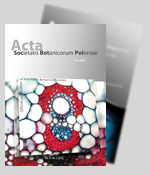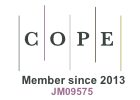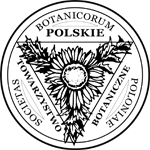In vitro shoot cultures of pink rock-rose (Cistus ×incanus L.) as a potential source of phenolic compounds
Abstract
Keywords
Full Text:
PDFReferences
Guzmán B, Vargas P. Systematics, character evolution, and biogeography of Cistus L. (Cistaceae) based on ITS, trnL-trnF, and matK sequences. Mol Phylogenet Evol. 2005;37:644–660. https://doi.org/10.1016/j.ympev.2005.04.026
Kubica P, Szopa A, Ekiert H, Ekiert RJ. Gatunki rodzaju Cistus sp. – taksonomia, występowanie, skład chemiczny, aplikacje terapeutyczne i badania biotechnologiczne. Postępy Fitoterapii. 2016;3:179–188.
Papaefthimiou D, Papanikolaou A, Falara V, Givanoudi S, Kostas S, Kanellis AK. Genus Cistus: a model for exploring labdane-type diterpenes’ biosynthesis and a natural source of high value products with biological, aromatic, and pharmacological properties. Front Chem. 2014;2:35. https://doi.org/10.3389/fchem.2014.00035
Loizzo MR, Ben Jemia M, Senatore F, Bruno M, Menichini F, Tundis R. Chemistry and functional properties in prevention of neurodegenerative disorders of five Cistus species essential oils. Food Chem Toxicol. 2013;59:586–594. https://doi.org/10.1016/j.fct.2013.06.040
Pomponio R, Gotti R, Santagati NA, Cavrini V. Analysis of catechins in extracts of Cistus species by microemulsion electrokinetic chromatography. J Chromatogr A. 2003;990:215–223. https://doi.org/10.1016/S0021-9673(02)02010-1
Küpeli E, Yesilada E. Flavonoids with anti-inflammatory and antinociceptive activity from Cistus laurifolius L. leaves through bioassay-guided procedures. J Ethnopharmacol. 2007;112:524–530. https://doi.org/10.1016/j.jep.2007.04.011
Attaguile G, Perticone G, Mania G, Savoca F, Pennisi G, Salomone S. Cistus incanus and Cistus monspeliensis inhibit the contractile response in isolated rat smooth muscle. J Ethnopharmacol. 2004;92:245–250. https://doi.org/10.1016/j.jep.2004.02.020
Attaguile G, Russo A, Campisi A, Savoca F, Acquaviva R, Ragusa N, et al. Antioxidant activity and protective effect on DNA cleavage of extracts from Cistus incanus L. and Cistus monspeliensis L. Cell Biol Toxicol. 2000;16:83–90. https://doi.org/10.1023/A:1007633824948
Barrajón-Catalán E, Fernández-Arroyo S, Roldán C, Guillén E, Saura D, Segura-Carretero A, et al. A systematic study of the polyphenolic composition of aqueous extracts deriving from several Cistus genus species: evolutionary relationship. Phytochem Anal. 2011;22:303–312. https://doi.org/10.1002/pca.1281
Skorić M, Todorović S, Gligorijević N, Janković R, Živković S, Ristić M, et al. Cytotoxic activity of ethanol extracts of in vitro grown Cistus creticus subsp. creticus L. on human cancer cell lines. Ind Crops Prod. 2012;38:153–159. https://doi.org/10.1016/j.indcrop.2012.01.017
Murashige T, Skoog F. A revised medium for rapid growth and bio assays with tobacco tissue cultures. Physiol Plant. 1962;15:473–497. https://doi.org/10.1111/j.1399-3054.1962.tb08052.x
M’Kada J, Dorion N, Bigot C. In vitro propagation of Cistus × purpureus Lam. Sci Hortic. 1991;46:155–160. https://doi.org/10.1016/0304-4238(91)90101-4
Iriondo JM, Moreno C, Pérez C. Micropropagation of six rockrose (Cistus) species. HortScience. 1995;30(5):1080–1081.
Pela Z, Pentcheva M, Gerasopoulos D, Maloupa E. In vitro induction of adventitious roots and proliferation of Cistus creticus creticus L. plants. Acta Hortic. 2000;541:317–322. https://doi.org/10.17660/ActaHortic.2000.541.49
Zygomala AM, Ioannidis C, Koropouli X. In vitro propagation of Cistus creticus L. Acta Hortic. 2003;616:391–396. https://doi.org/10.17660/ActaHortic.2003.616.59
Madesis P, Konstantinidou E, Tsaftaris A, Nianiou-Obeidat I. Micropropagation and shoot regeneration of Cistus creticus ssp. creticus. J Appl Pharm Sci. 2011;1:54–58.
Ellnain-Wojtaszek M, Zgórka G. High-performance liquid chromatography and thin-layer chromatography of phenolic acids from Ginkgo biloba L. leaves collected within vegetative period. J Liq Chromatogr Relat Technol. 1999;10:1457–1471. https://doi.org/10.1081/JLC-100101744
Sułkowska-Ziaja K, Maślanka A, Szewczyk A, Muszyńska B. Determination of physiologically active compounds in four species of genus Phellinus. Nat Prod Commun. 2017;12:363–366
Szopa A, Ekiert H, Szewczyk A, Fugas E. Production of bioactive phenolic acids and furanocoumarins in in vitro cultures of Ruta graveolens L. and Ruta graveolens ssp. divaricata (Tenore) Gams. under different light conditions. Plant Cell Tissue Organ Cult. 2012;110(3):329–336. https://doi.org/10.1007/s11240-012-0154-5
Ekiert H, Piekoszewska A, Muszyńska B, Baczyńska S. Accumulation of p-coumaric acid and other bioactive phenolic acids in in vitro culture of Ruta graveolens ssp. divaricata (Tenore) Gams. Medicina Internacia Revuo. 2014;26(102):24–31.
Szopa A, Kokotkiewicz A, Marzec-Wróblewska U, Bucinski A, Luczkiewicz M, Ekiert H. Accumulation of dibenzocyclooctadiene lignans in agar cultures and in stationary and agitated liquid cultures of Schisandra chinensis (Turcz.) Baill. Appl Microbiol Biotechnol. 2016;100(9):3965–3977. https://doi.org/10.1007/s00253-015-7230-9
Ono K, Nakao M, Toyota M, Terashi Y, Yamada M, Kohno T, et al. Catechin production in cultured Polygonum hydropiper cells. Phytochemistry. 1998;49:1935–1939. https://doi.org/10.1016/S0031-9422(98)00426-9
Tanaka N, Shimomura K, Ishimaru K. Tannin production in callus cultures of Quercus acutissima. Phytochemistry. 1995;40:1151–1154. https://doi.org/10.1016/0031-9422(95)00378-K
Moumou Y, Vasseur J, Trotin F, Dubois J. Catechin production by callus cultures of Fagopyrum esculentum. Phytochemistry. 1992;31:1239–1241. https://doi.org/10.1016/0031-9422(92)80267-I
Bouamama H, Noël T, Villard J, Benharref A, Jana M. Antimicrobial activities of the leaf extracts of two Moroccan Cistus L. species. J Ethnopharmacol. 2006;104:104–107. https://doi.org/10.1016/j.jep.2005.08.062
Santagati NA, Salerno L, Attaguile G, Savoca F, Ronsisvalle G. Simultaneous determination of catechins, rutin, and gallic acid in Cistus species extracts by HPLC with diode array detection. J Chromatogr Sci. 2008;46:150–156. https://doi.org/10.1093/chromsci/46.2.150
Tusevski O, Petreska Stanoeva J, Stefova M, Pavokovic D, Gadzovska Simic S. Identification and quantification of phenolic compounds in Hypericum perforatum L. transgenic shoots. Acta Physiol Plant. 2014;36:2555–2569. https://doi.org/10.1007/s11738-014-1627-4
Kwiecień I, Szydłowska A, Kawka B, Beerhues L, Ekiert H. Accumulation of biologically active phenolic acids in agitated shoot cultures of three Hypericum perforatum cultivars: ‘Elixir’, ‘Helos’ and ‘Topas’. Plant Cell Tissue Organ Cult. 2015;123:273–281. https://doi.org/10.1007/s11240-015-0830-3
Rainha N, Koci K, Coelho AV, Lima E, Baptista J, Fernandes-Ferreira M. HPLC-UV-ESI-MS analysis of phenolic compounds and antioxidant properties of Hypericum undulatum shoot cultures and wild-growing plants. Phytochemistry. 2013;86:83–91. https://doi.org/10.1016/j.phytochem.2012.10.006
Giri L, Dhyani P, Rawat S, Bhatt ID, Nandi SK, Rawal RS, et al. In vitro production of phenolic compounds and antioxidant activity in callus suspension cultures of Habenaria edgeworthii: a rare Himalayan medicinal orchid. Ind Crops Prod. 2012;39:1–6. https://doi.org/10.1016/j.indcrop.2012.01.024
Santos-Gomes PC, Seabra RM, Andrade PB, Fernandes-Ferreira M. Phenolic antioxidant compounds produced by in vitro shoots of sage (Salvia officinalis L.). Plant Sci. 2002;162:981–987. https://doi.org/10.1016/S0168-9452(02)00052-3
Szopa A, Ekiert H. In vitro cultures of Schisandra chinensis (Turcz.) Baill. (Chinese magnolia vine) – a potential biotechnological rich source of therapeutically important phenolic acids. Appl Biochem Biotechnol. 2012;166:1941–1948. https://doi.org/10.1007/s12010-012-9622-y
Ali M, Abbasi BH, Ihsan UH. Production of commercially important secondary metabolites and antioxidant activity in cell suspension cultures of Artemisia absinthium L. Ind Crops Prod. 2013;49:400–406. https://doi.org/10.1016/j.indcrop.2013.05.033
Dhalwal K, Shinde VM, Biradar YS, Mahadik KR. Simultaneous quantification of bergenin, catechin, and gallic acid from Bergenia ciliata and Bergenia ligulata by using thin-layer chromatography. J Food Compost Anal. 2008;21:496–500. https://doi.org/10.1016/j.jfca.2008.02.008
Szopa A, Ekiert H, Muszyńska B. Accumulation of hydroxybenzoic acids and other biologically active phenolic acids in shoot and callus cultures of Aronia melanocarpa (Michx.) Elliott (black chokeberry). Plant Cell Tissue Organ Cult. 2013;113(2):323–329. https://doi.org/10.1007/s11240-012-0272-0
Szopa A, Ekiert H. Production of biologically active phenolic acids in Aronia melanocarpa (Michx.) Elliott in vitro cultures cultivated on different variants of the Murashige and Skoog medium. Plant Growth Regul. 2014;72(1):51–58. https://doi.org/10.1007/s10725-013-9835-2
Kokotkiewicz A, Wnuk M, Bucinski A, Luczkiewicz M. In vitro cultures of Cyclopia plants (honeybush) as a source of bioactive xanthones and flavanones. Z Naturforsch C. 2009;64(7–8):533–540. https://doi.org/10.1515/znc-2009-7-812
Luczkiewicz M, Kokotkiewicz A. Genista tinctoria hairy root cultures for selective production of isoliquiritigenin. Z Naturforsch C. 2005;60(11–12):867–875. https://doi.org/10.1515/znc-2005-11-1209
Szopa A, Kokotkiewicz A, Luczkiewicz M, Ekiert H. Schisandra lignans production regulated by different bioreactor type. J Biotechnol. 2017;247:11–17. https://doi.org/10.1016/j.jbiotec.2017.02.007
Xiong L, Li J, Li Y, Yuan L, Liu S, Huang J, Liu Z. Dynamic changes in catechin levels and catechin biosynthesis-related gene expression in albino tea plants (Camellia sinensis L.). Plant Physiol Biochem. 2013;71:132–143. https://doi.org/10.1016/j.plaphy.2013.06.019
DOI: https://doi.org/10.5586/asbp.3563
|
|
|








